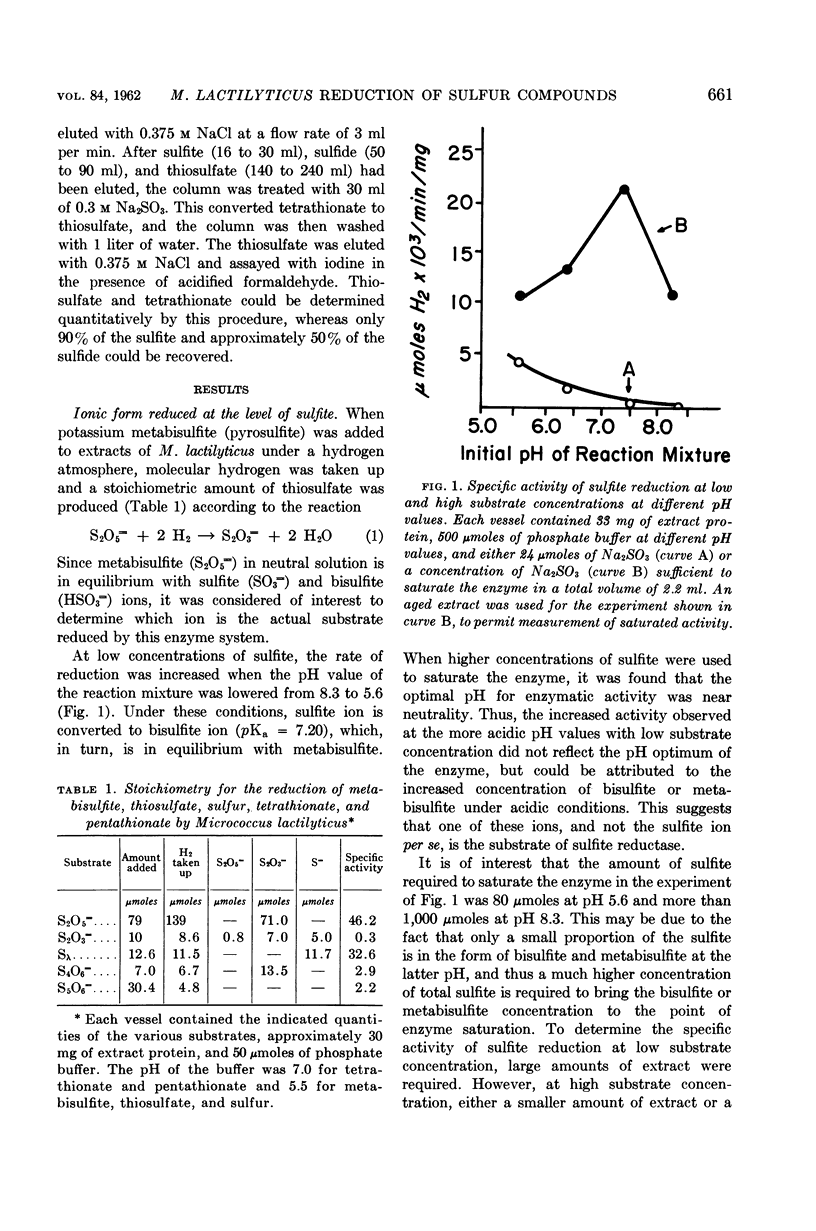Abstract
Woolfolk, C. A. (University of Washington, Seattle). Reduction of inorganic compounds with molecular hydrogen by Micrococcus lactilyticus. II. Stoichiometry with inorganic sulfur compounds. J. Bacteriol. 84:659–668. 1962.—Extracts of Micrococcus lactilyticus (Veillonella alcalescens) are capable of utilizing molecular hydrogen for the reduction of metabisulfite (pyrosulfite) to thiosulfate via dithionite as an intermediate. The first step of metabisulfite reduction (i.e., to dithionite) is reversible, and, when dithionite is added as a substrate, there is an evolution of molecular hydrogen accompanied by the formation of equilibrium concentrations of metabisulfite. Kinetic studies indicate that dithionite may be directly reduced to thiosulfate without the formation of sulfoxylate as an intermediate. Although tetrathionate is reduced to thiosulfate with an uptake of hydrogen, polythionates probably are not formed as intermediates in the reduction of metabisulfite to thiosulfate.
Full text
PDF









Selected References
These references are in PubMed. This may not be the complete list of references from this article.
- Foubert E. L., Douglas H. C. Studies on the Anaerobic Micrococci: I. Taxonomic Considerations. J Bacteriol. 1948 Jul;56(1):25–34. [PMC free article] [PubMed] [Google Scholar]
- HILZ H., KITTLER M., KNAPE G. [The reduction of sulfate in yeast]. Biochem Z. 1959;332:151–166. [PubMed] [Google Scholar]
- HOROWITZ N. H. Biochemical genetics of Neurospora. Adv Genet. 1950;3:33–71. doi: 10.1016/s0065-2660(08)60082-6. [DOI] [PubMed] [Google Scholar]
- LEAL R. S., GREENBAUM A. L. The effect of pituitary growth hormone on phospholipid synthesis. Biochem J. 1961 Jul;80:27–34. doi: 10.1042/bj0800027. [DOI] [PMC free article] [PubMed] [Google Scholar]
- MAGER J. A TPNH-linked reductase and its relation to hydroxylamine reductase in Enterobacteriaceae. Biochim Biophys Acta. 1960 Jul 15;41:553–555. doi: 10.1016/0006-3002(60)90065-2. [DOI] [PubMed] [Google Scholar]
- MORTLOCK R. P., WOLFE R. S. Reversal of pyruvate oxidation in Clostridium butyricum. J Biol Chem. 1959 Jul;234(7):1657–1658. [PubMed] [Google Scholar]
- NAKAMURA T. Biochemical genetical studies on the pathway of sulphate assimilation in Aspergillus nidulans. J Gen Microbiol. 1962 Feb;27:221–230. doi: 10.1099/00221287-27-2-221. [DOI] [PubMed] [Google Scholar]
- NAKAMURA T., SATO R. Accumulation of S-sulphocysteine by a mutant strain of Aspergillus nidulans. Nature. 1962 Feb 3;193:481–482. doi: 10.1038/193481a0. [DOI] [PubMed] [Google Scholar]
- PECK H. D., Jr, GEST H. A new procedure for assay of bacterial hydrogenases. J Bacteriol. 1956 Jan;71(1):70–80. doi: 10.1128/jb.71.1.70-80.1956. [DOI] [PMC free article] [PubMed] [Google Scholar]
- POLLARD F. H. Inorganic chromatography. Br Med Bull. 1954;10(3):187–192. doi: 10.1093/oxfordjournals.bmb.a069419. [DOI] [PubMed] [Google Scholar]
- POSTGATE J. R. Cytochrome c3 and desulphoviridin; pigments of the anaerobe Desulphovibrio desulphuricans. J Gen Microbiol. 1956 Jul;14(3):545–572. doi: 10.1099/00221287-14-3-545. [DOI] [PubMed] [Google Scholar]
- POSTGATE J. R. The reduction of sulphur compounds by Desulphovibrio desulphuricans. J Gen Microbiol. 1951 Oct;5(4):725–738. doi: 10.1099/00221287-5-4-725. [DOI] [PubMed] [Google Scholar]
- Peck H. D. THE ATP-DEPENDENT REDUCTION OF SULFATE WITH HYDROGEN IN EXTRACTS OF DESULFOVIBRIO DESULFURICANS. Proc Natl Acad Sci U S A. 1959 May;45(5):701–708. doi: 10.1073/pnas.45.5.701. [DOI] [PMC free article] [PubMed] [Google Scholar]
- WHITELEY H. R., DOUGLAS H. C. The fermentation of purines by Micrococcus lactilyticus. J Bacteriol. 1951 May;61(5):605–616. doi: 10.1128/jb.61.5.605-616.1951. [DOI] [PMC free article] [PubMed] [Google Scholar]


